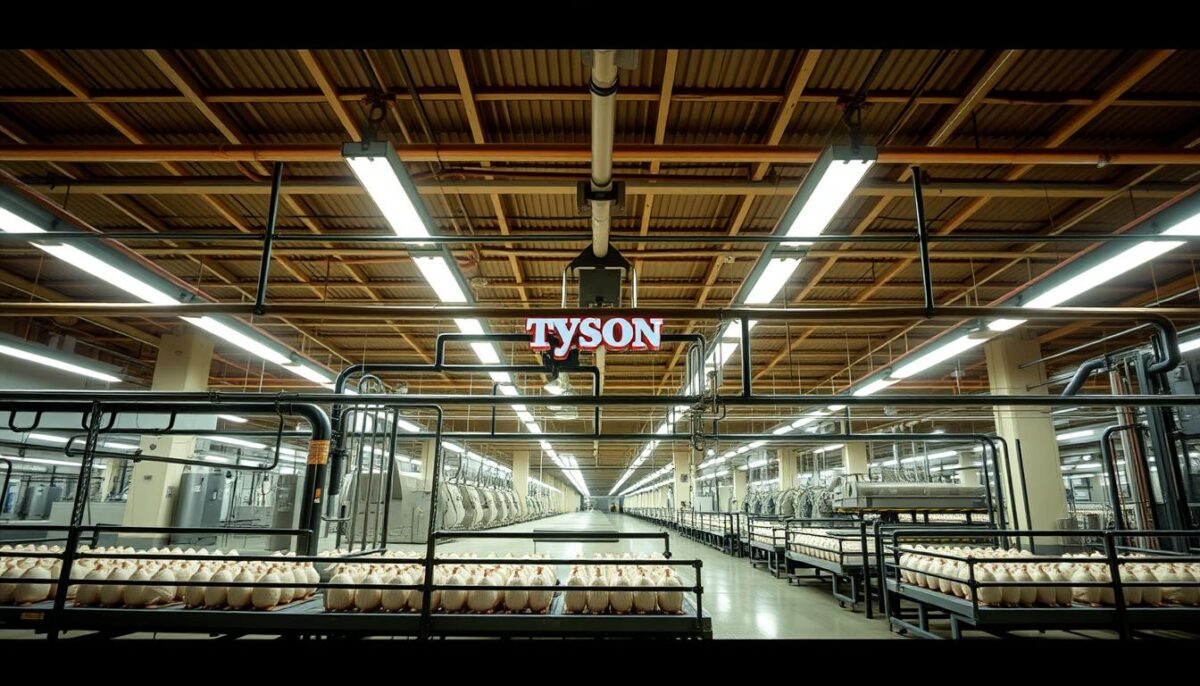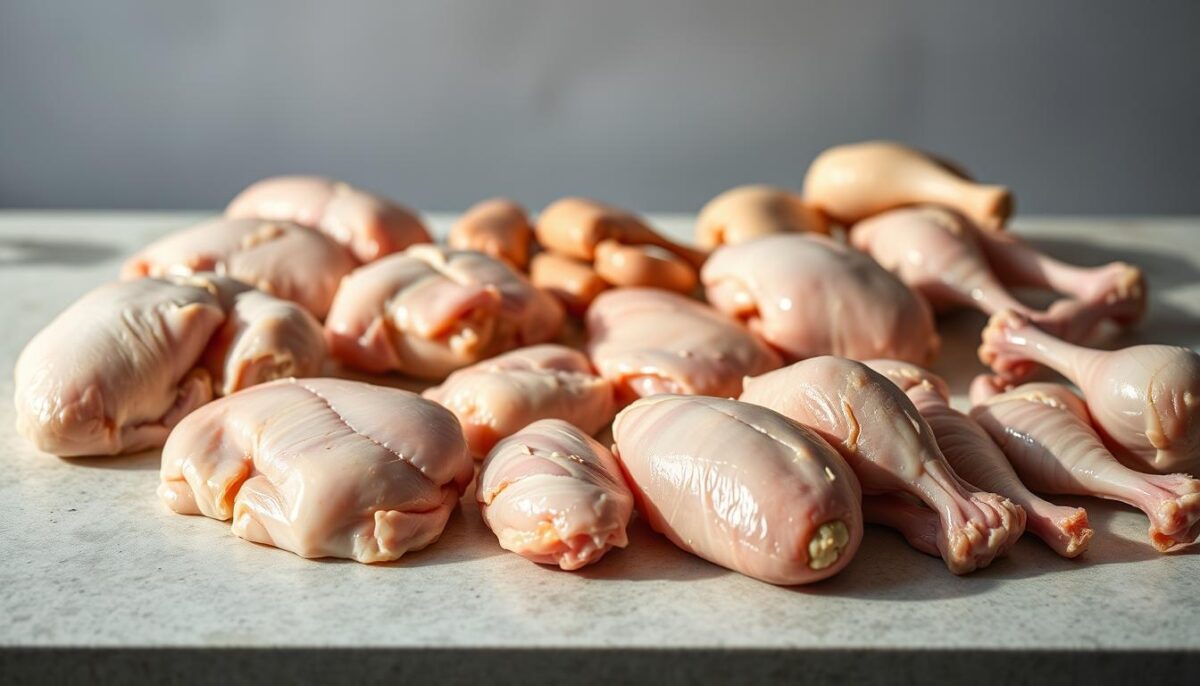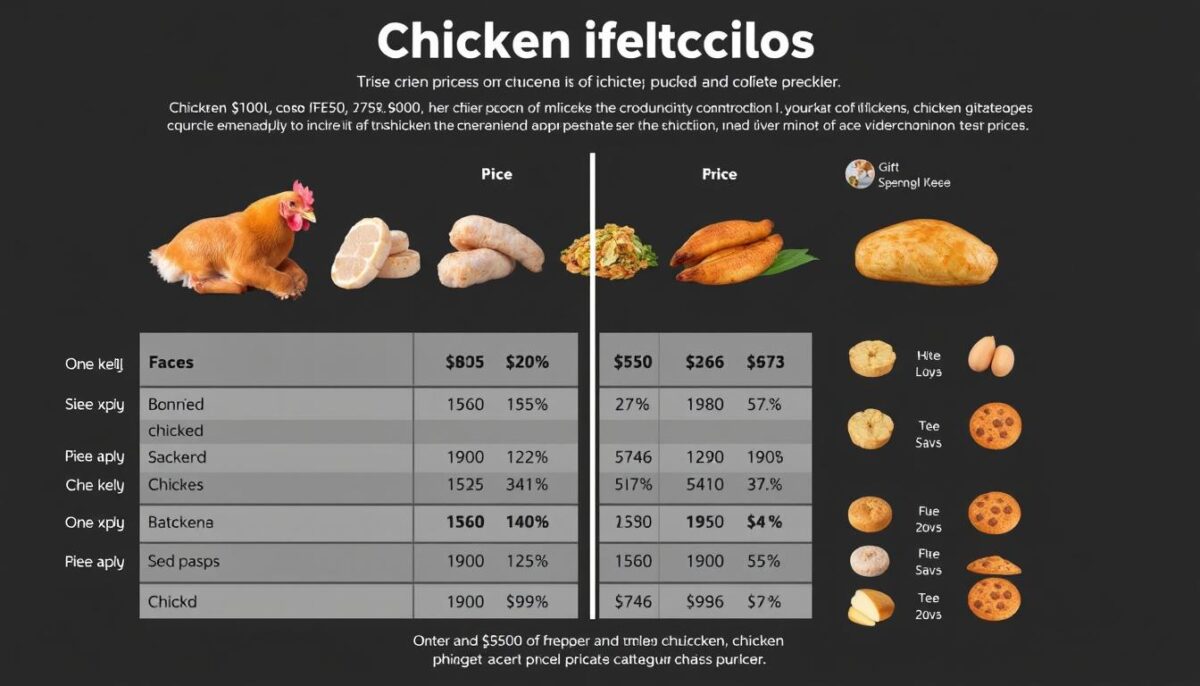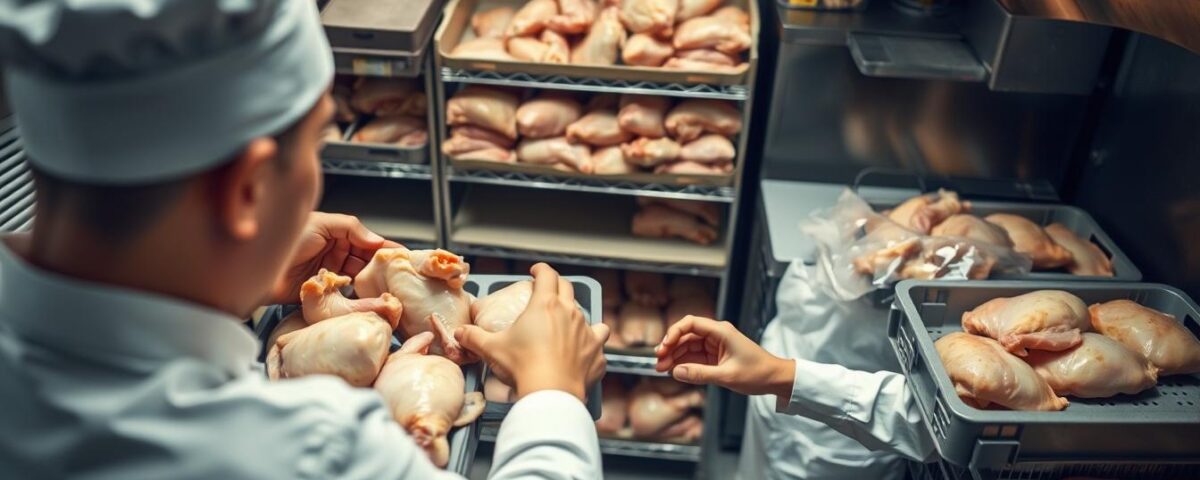
6 Hidden Factors to Compare Wholesale Food Distributors
August 21, 2025
How to Use a Food Cost Template to Boost Margins 15 %
August 22, 2025As a restaurant owner, finding the right balance between quality and cost when sourcing chicken products can be a daunting task. I recall a conversation with a client who was struggling to maintain profitability due to the high costs of poultry from unreliable suppliers.
According to the USDA, the US’s production of broiler chickens was worth $23.2 billion in 2023, highlighting the scale of the industry. With such a significant market, it’s crucial to navigate it effectively. The challenge lies in identifying high-quality chicken products without compromising on food safety or overspending.
So, how can you ensure you’re getting the best poultry products for your restaurant without breaking the bank? The key lies in a systematic approach to vetting suppliers, which I’ll outline in this guide.
Key Takeaways
- Understand the current supplier landscape to make informed decisions.
- Implement a proven system for vetting suppliers to ensure quality products.
- Build long-term relationships with suppliers that benefit both your business and customers.
- Save thousands of dollars annually by proper supplier vetting.
- Maintain consistent product quality across your operations.
The Current Landscape of Chicken Suppliers in the US
Understanding the current state of chicken suppliers in the US is crucial for restaurant owners to make informed decisions. The chicken supply market in the United States is diverse, with a few major players dominating the industry, alongside hundreds of regional and specialty suppliers.
According to US export data, the top chicken producers in the USA include Tyson Foods ($1.12 billion), Pilgrim’s Pride Corporation ($900 million), and Sanderson Farms ($360 million). These large producers have a significant market share, but regional suppliers can offer more flexibility and customized solutions for specific restaurant needs.
Top 10 Chicken Producers Worth Considering
The largest chicken suppliers in the US are led by industry giants like Tyson Foods, which holds a 25% market share. Other notable producers include Perdue Farms, Foster Farms, and Koch Foods.

Understanding Different Types of Chicken Products
The variety of chicken products available has expanded significantly, with suppliers offering a wide range of options, from basic whole birds to highly specialized pre-portioned items. Additionally, many chicken suppliers now include turkey products in their offerings, providing menu diversity without requiring additional vendor relationships.
Understanding the different types of poultry products available, such as fresh, frozen, pre-marinated, and pre-cooked, is essential for restaurant owners to assess their menu needs and storage requirements effectively.
How I Vet Chicken Suppliers for Restaurants
When it comes to sourcing chicken products, I’ve developed a systematic vetting process that prioritizes quality and safety. This process is crucial for restaurants to maintain high standards and ensure customer satisfaction.
Essential Questions to Ask Potential Suppliers
Understanding a supplier’s position in the market is vital. I ask whether they are direct producers, distributors, or brokers, as each has different advantages and potential issues. I also inquire about their cold chain management, as temperature control is critical for maintaining poultry quality and safety throughout transportation.
One of the most revealing questions I ask is about their contingency plans for supply disruptions. Reliable suppliers always have backup systems in place to ensure consistent delivery of high-quality chicken products.
- What is your role in the supply chain?
- How do you manage cold chain logistics?
- What contingency plans do you have for supply disruptions?
Red Flags That Signal Unreliable Suppliers
Through my experience, I’ve identified several red flags that signal unreliable suppliers. These include reluctance to provide facility tours, inconsistent pricing structures, and inability to provide clear information about product origins.
Documentation and Certifications to Request
Documentation is non-negotiable in my vetting process. I request HACCP plans, third-party audit results, and USDA inspection records before considering any new supplier. The most reliable suppliers are transparent about their sourcing practices and can trace their meat products back to specific farms or processing facilities.
By following this vetting process, restaurants can ensure they’re working with suppliers who meet their quality needs and can provide consistent, high-quality chicken products.
Evaluating Product Quality Without Being an Expert
As a seasoned expert, I’ve created simple yet effective ways to evaluate chicken quality without being an expert. When sourcing poultry products for your restaurant, it’s crucial to assess their quality to ensure customer satisfaction and maintain your establishment’s reputation.
Key Quality Indicators for Fresh Chicken
For fresh chicken, I recommend checking for several key indicators. These include:
- Firm texture
- Natural color without discoloration
- Minimal moisture in packaging
- A clean, neutral smell
These characteristics signify high-quality chicken breasts and other fresh poultry products.
Quality Benchmarks for Frozen Chicken Products
When evaluating frozen chicken products, different criteria apply. Look for:
- Absence of freezer burn
- No ice crystallization (which can indicate thawing and refreezing)
- Intact package integrity
These benchmarks help ensure that your frozen chicken products maintain their quality and safety.
Sampling Strategies That Save Money and Time
To efficiently evaluate chicken products without significant investment, I suggest a strategic sampling approach. Request small quantities of multiple products from potential suppliers rather than large amounts of a single item. This allows for a comprehensive comparison without excessive cost.
Additionally, consider conducting blind taste tests with your kitchen staff to compare similar products from different suppliers. This method eliminates brand bias and focuses on the actual quality of the poultry products.

For specialty items like duck or turkey products, evaluate their performance both alone and in your signature recipes, as their quality can vary when combined with other ingredients. When assessing chicken wings, consider their cooking performance, including yield, sauce adhesion, and texture retention.
Balancing Cost and Quality in Chicken Procurement
Restaurants must navigate the complex landscape of chicken suppliers to find the optimal balance between cost and quality. Effective procurement strategies are crucial to maintaining profitability without compromising on the quality of chicken products served to customers.
Price Comparison Strategies That Work
To compare chicken supplier prices effectively, it’s essential to standardize units across suppliers. I always convert to cost per serving or cost per ounce rather than comparing case prices. For instance, when evaluating Tyson Red Label products, which range from $39.24 to $53.24 per case, it’s crucial to consider the cost per unit.

Volume Discounts and Contract Negotiations
When negotiating with chicken suppliers, I focus on total value rather than just the base price, including factors like delivery reliability, credit terms, and support services. Bulk chicken breasts from Amick Farms, for example, cost approximately $157.04 for a 40 lb. case ($0.25/ounce). Understanding the total cost, including storage and potential waste, is vital.
When Premium Products Are Worth the Extra Cost
For many restaurants, a mixed approach works best – using premium products like Red Label chicken breasts for signature dishes while using more economical options for items where quality differences are less noticeable. Evaluating the labor savings against the premium price for specialty items like skinless chicken wings helps determine their true value.
By adopting a comprehensive approach to chicken procurement, restaurants can achieve a balance between cost and quality. This involves understanding regional price variations, leveraging local poultry offerings, and developing different purchasing strategies for high and low seasons.
Conclusion: Creating Long-Term Supplier Relationships
The journey to finding the right chicken suppliers is just the beginning; cultivating long-term relationships is where the real value lies. Throughout my career working with restaurants, I’ve found that the most successful operations view their chicken suppliers as strategic partners rather than just vendors.
Establishing clear communication channels with suppliers has repeatedly proven to be the most effective way to ensure consistent access to high-quality chicken products over time. I recommend scheduling regular review meetings with key suppliers to discuss menu changes, upcoming promotions, and market trends that might affect pricing or availability.
The data shows that restaurants that maintain long-term relationships with poultry suppliers often gain access to new products earlier and receive priority during supply shortages. For specialty items like oven roasted chicken wings or popcorn chicken, developing relationships with suppliers who can provide consistent products that match your specific recipe needs is crucial.
Many restaurants have found success by working directly with suppliers like Koch Foods to develop custom poultry items that differentiate their menu offerings from competitors. When evaluating the total value of a supplier relationship, I consider factors beyond just price – including delivery flexibility, product innovation, and technical support for kitchen staff.
By prioritizing the development of robust relationships with chicken suppliers, restaurants can ensure a stable supply of high-quality chicken and stay ahead in the competitive US food industry. This approach not only enhances menu consistency but also provides a foundation for long-term success.
FAQ
What are the key factors to consider when evaluating chicken products for my restaurant?
When evaluating chicken products, I consider factors such as quality, price, and certifications like food safety compliance. I also assess the supplier’s ability to meet my bulk needs and provide consistent high-quality chicken.
How do I ensure the fresh chicken I receive is of high quality?
To ensure fresh chicken quality, I check for proper handling and storage procedures, inspect the product for visible signs of spoilage, and verify the supplier’s adherence to food safety guidelines. I also consider the origin of the chicken breasts and the supplier’s reputation.
What are the benefits of working with a supplier that offers a wide range of poultry products?
Working with a supplier that offers a wide range of poultry products, such as chicken wings, tenders, and breast meat, allows me to simplify my procurement process and potentially negotiate better prices due to the increased volume of my order.
How can I effectively compare prices among different chicken suppliers?
To compare prices effectively, I consider not only the cost per unit but also factors like product quality, packaging, and any additional services the supplier may offer, such as oven-roasted or popcorn chicken options.
Are frozen chicken products as safe and nutritious as fresh chicken?
Frozen chicken products can be just as safe and nutritious as fresh chicken if they are handled and stored properly. I look for suppliers that follow proper freezing and storage procedures to maintain the quality of their frozen products.
What certifications should I look for when vetting chicken suppliers?
When evaluating suppliers, I look for certifications such as USDA inspection and compliance with food safety regulations. These certifications help ensure that the supplier is providing high-quality chicken products that meet regulatory standards.



